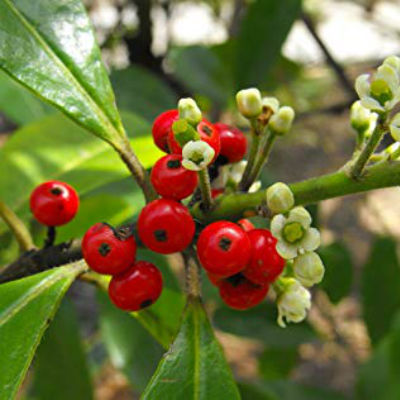Yerba Mate

| Binomial Name | Ilex paraguariensis |
| Family | Aquifoliaceae |
| Order | Aquifoliales |
| Kingdom | Plantae |
| Genus | Ilex |
Yerba Matte (Ilex paraguariensis)
A perennial shrub, belonging to the Holly family, Yerba Mate is native to mostly Southern and Central regions of South America, including Bolivia, Venezuela, Brazil and southern Chile. Its leaves are evergreen, leafing in all four seasons, and grows best in the shade, away from direct sunlight. Yerba Mate that is grown under sheds or in the shadows of taller trees tend to retain more of the nutrients and phytochemicals, and usually have the strongest flavour.
Yerba mate was first cultivated and used by the indigenous Guaraní people and in some Tupí communities in southern Brazil, and is said in folklore to be a gift of the Gods for Vitality, Strength and Vigour. It was consumed by soldiers during battle, and also used as a medicinal herb by Shamans and Ayahuasceros to treat various ailments and conditions. The stimulant properties of the beverage became popular with Argentinian gauchos (or cowboys), who sipped yerba mate for energy during cattle drives or long harvest days. It was also consumed in place of scarce food during periods of drought or famine.
Today, it is a popular beverage across almost all of South America. It is still served ceremoniously, steeped in a wide angled cup and sipped with a metal sieved straw called a ‘Bombilla’. The taste is Earthy, herbaceous and kind of bittersweet, with the fragrance of a rainforest floor. If steeped for longer, or at higher temperatures, it extracts more of the potent tannins, giving the body a little more astringency. Some producers roast the leaves and twigs for a toasted flavor. Others age the harvested herb in wood containers to impart even more layers of forest-like flavor.
Constituents:
Yerba Mate contains a variety of polyphenols, including the flavonoids quercetin and rutin. But the main active ingredients that give Yerba Matte its distinct refreshing characteristics are its Xanthines, which are Caffeine, theobromine and theophylline.
Theobromine is also found in chocolate. It increases dopamine levels, and is the ‘feel good’ component of Chocolate. The caffeine content in Yerba Mate is higher than black tea, but not as much as in Coffee. The combination of these levels and ingredients makes Yerba Mate quite a unique beverage, where the excitation effect is not quite mild as green tea, nor as jittery and stimulating like coffee, but just a pleasant, slow rise, kind of rejuvenating like you’ve just woken up from a refreshing nap.
Yerba Mate also contains minerals potassium, magnesium and manganese.
Benefits
1. Improves High Cholesterol
Yerba Mate significantly reduced blood cholesterol, glutathione reductase, and hardening of arteries (cholesterol-related damage) in rabbits. Yerba Mate also decreased LDL and increased HDL (good cholesterol) in patients on long-term statin therapy more than statins alone, according to a study on 30 patients with high cholesterol
2. Provides a smooth increase in energy.
Yerba mate is well known for providing an energy boost that’s been described as gentle, clean, and calm. Compared to the other most commonly used stimulants in the world — coffee, tea, kola nut, cocoa, and guarana — yerba mate reportedly delivers the most balanced energy boost. Yerba mate drinkers experience a state of alert wakefulness similar to that of coffee, but without coffee’s side effects. It rarely interferes with sleep and doesn’t cause caffeine jitters and is used prevalently by athletes to enhance physical performance.
3. Yerba Mate may be effective in Preventing Cancer
Cancer cells have more topoisomerase II, an enzyme required for cell division, than normal cells. Yerba Mate decreased topoisomerase II and confers a cytotoxic effect on human liver cancer cells
4. Prevents Heart Diseases
Yerba Mate improved the recovery from heart damage, as seen in experiments with rat tissues. Another study showed that Yerba Mate relaxed arterial beds and improved blood flow in rats.
5.Helps keep Diabetes in control
Yerba Mate causes a significant dose-dependant reduction of AGEs (advanced glycation end products) mainly through stopping the second phase of AGE production, which is a result of Yerba Mate’s antioxidant capacity
Yerba Mate also demonstrates lowered blood glucose in mice, which is another way of preventing AGE production. Yerba Mate may have an additional effect on diabetes by lowering insulin resistance
6. Yerba mate boosts mental function
The flavonoids in Yerba Mate, caffeine and theobromine improve mental focus and acuity, and is useful in enhancing focus and concentration. It is also known to improve memory.
7. Prevents DNA Mutation
Yerba Mate is an anti-mutagen, which prevents DNA damage and improves DNA repair after oxidation damage.
8. Yerba Mate Has Antioxidant Effects
Yerba Mate is a rich source of polyphenols with antioxidant properties significantly stronger than green tea, according to test-tube experiments. Thus, Yerba Mate likely prevents heart and blood flow disease, cancer, aging, and autoimmune disorders through its antioxidant capacity
9.Prevents Neurodegenerative Disorders
According to one review, Yerba Mate contains methylxanthines that combat Parkinson’s and Alzheimer’s, both disorders of the nervous system.